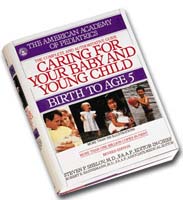
|
| SEARCH MEDICAL LIBRARY |  |
|
› Home » Medical Library Medical Library 
Baby's First Month: Appearance and Growth
In the very beginning, it may seem that your baby does nothing but eat, sleep, cry and fill her diapers. By the end of the first month, she'll be much more alert and responsive. Gradually, she'll begin moving her body more smoothly and with much greater coordination, especially in getting her hand to her mouth. You'll realize that she listens when you speak, watches you as you hold her, and occasionally moves her own body to respond to you or attract your attention. Weight When your baby was born, her birthweight included excess body fluid that was lost during her first few days. Most babies lose about one-tenth of their birthweight during the first five days, then regain it over the next five, so that by about day ten they usually are back to their original birthweight. You can plot your own infant's growth on charts. Most babies grow very rapidly after regaining their birthweight, especially during growth spurts which occur around seven to 10 days and again between three and six weeks. The average newborn gains weight at a rate of 2/3 of an ounce (20 to 30 grams) per day and by one month weighs about 9 pounds (4 kilograms). She grows between 1 and 1 1/2 inches (2.5 to 4 centimeters) during this month. Boys tend to weigh slightly more than girls (by less than 1 pound, or 400 grams). They also tend to be slightly longer than girls at this age (by about 1/2 inch, or 1.25 centimeters). Head Your pediatrician will pay particular attention to your child's head growth, because it reflects the growth of her brain. The skull should grow faster during the first four months than at any other time in her life. The measurement around the average newborn's head is about 13 3/4 inches (35 centimeters) and grows to about 14 3/4 inches (37.75 centimeters) by one month. Because boys tend to be slightly larger than girls, their heads are larger, though the average difference is less than 1/3 inch (1 centimeter). If your baby was born vaginally and her skull appeared misshapen at birth, it soon will resume its normal shape. Any bruising of the scalp or swelling of the eyelids that occurred during birth will be gone by the end of the first week or two. Any red spots in the eyes will disappear in about three weeks. To your dismay, you may discover that the fine hair that covered your child's head when she was born will soon begin falling out. If she rubs the back of her head on her bedding, she may develop a temporary bald spot there, even if the rest of her hair remains. This loss is insignificant. The bare spots will be covered with new hair in a few months. Body During these first weeks your baby's body gradually will straighten from the tightly curled position she held inside the uterus during the final months of pregnancy. She'll begin to stretch her arms and legs, and may arch her back from time to time. Her legs and feet may continue to rotate inward, giving her a bowlegged look. This condition usually will correct itself gradually over the next five to six months. If the bowlegged appearance is particularly severe or associated with pronounced curving in of the front part of the foot, your pediatrician may suggest a splint or a cast to correct it, but these circumstances are extremely unusual. By the third week, the stump from the umbilical cord should have dried and fallen off, leaving behind a clean, well-healed area. Occasionally, a raw spot is left after the stump is gone. It may even ooze a little blood-tinged fluid. Keep it clean and dry, and it will heal by itself. If it is not completely closed and dry in two weeks, consult your doctor. Skin "Baby acne" is a normal development of pimples that break out on the face, usually during the fourth or fifth week of life. They are thought to be due to stimulation of oil glands in the skin by hormones passed across the placenta during pregnancy. This condition may be made worse if the baby lies in sheets laundered in harsh detergents or soiled by milk that she's spit up. If your baby does have baby acne, place a soft, clean receiving blanket under her head and wash her face gently once a day with a mild baby soap to remove milk or detergent residue. Your newborn's skin also may look blotchy, ranging in color from pink to blue. Her hands and feet in particular may be colder and bluer than the rest of her body. The blood vessels leading to these areas are more sensitive to temperature changes and tend to shrink in response to cold. As a result, less blood gets to the exposed skin, causing it to look pale or bluish. If you move her arms and legs; however, you'll notice that they quickly turn pink again. Excerpted from Caring for Baby and Young Child: Birth to Age 5, Bantam 1999 |
|
 #) 
|
Copyright © 2003-2004 Medem, Inc. All Rights Reserved.

 Printer-friendly format
Printer-friendly format